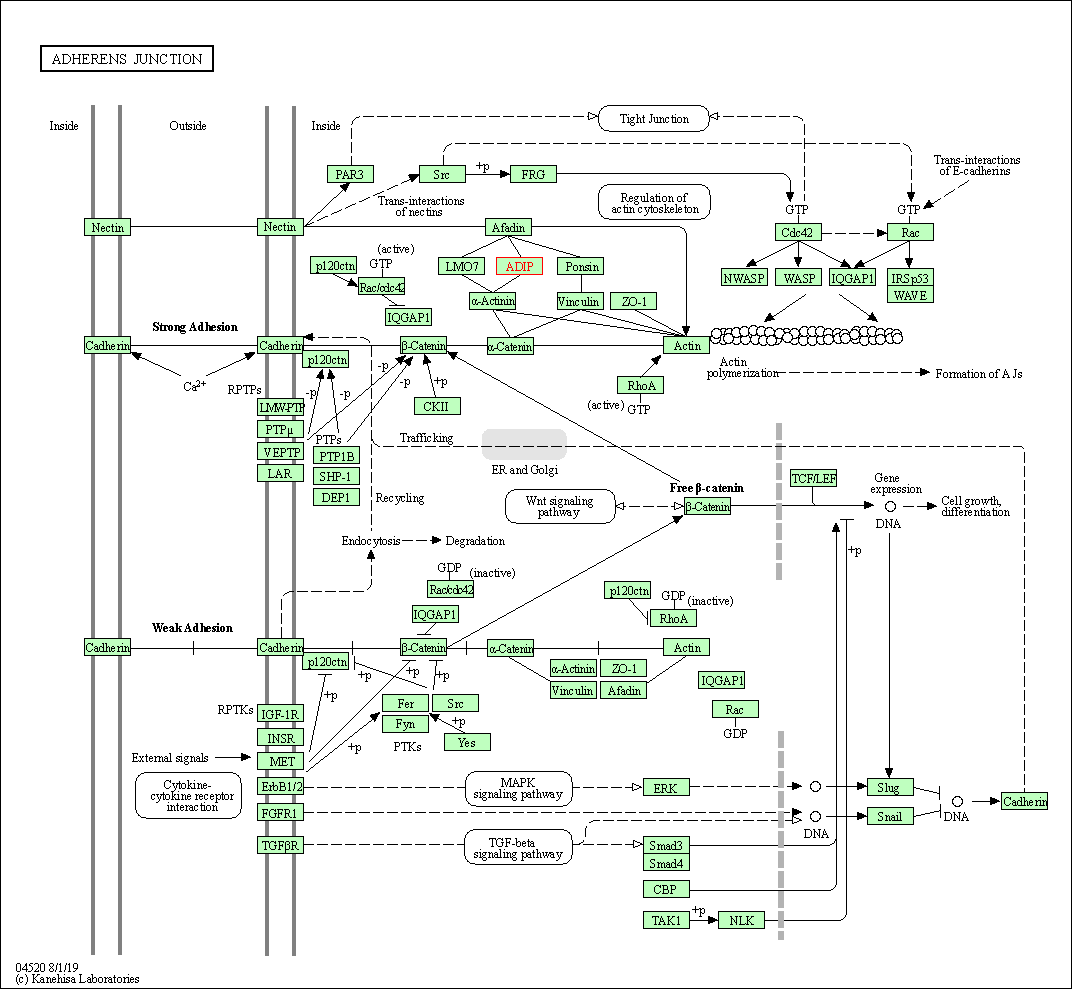Target Information
| Target General Information | Top | |||||
|---|---|---|---|---|---|---|
| Target ID |
T75947
(Former ID: TTDNR00637)
|
|||||
| Target Name |
SSX2-interacting protein (SSX2IP)
|
|||||
| Synonyms |
KIAA0923; Afadin- and alpha-actinin-binding protein; Afadin DIL domain-interacting protein; ADIP
Click to Show/Hide
|
|||||
| Gene Name |
SSX2IP
|
|||||
| Target Type |
Literature-reported target
|
[1] | ||||
| Function |
May connect the nectin-afadin and E-cadherin-catenin system through alpha-actinin and may be involved in organization of the actin cytoskeleton at AJs through afadin and alpha-actinin. Involved in cell movement: localizes at the leading edge of moving cells in response to PDGF and is required for the formation of the leading edge and the promotion of cell movement, possibly via activation of Rac signaling. Acts as a centrosome maturation factor, probably by maintaining the integrity of the pericentriolar material and proper microtubule nucleation at mitotic spindle poles. The function seems to implicate at least in part WRAP73; the SSX2IP:WRAP73 complex is proposed to act as regulator of spindle anchoring at the mitotic centrosome. Involved in ciliogenesis. It is required for targeted recruitment of the BBSome, CEP290, RAB8, and SSTR3 to the cilia. Belongs to an adhesion system, which plays a role in the organization of homotypic, interneuronal and heterotypic cell-cell adherens junctions (AJs).
Click to Show/Hide
|
|||||
| UniProt ID | ||||||
| Sequence |
MGDWMTVTDPGLSSESKTISQYTSETKMSPSSLYSQQVLCSSIPLSKNVHSFFSAFCTED
NIEQSISYLDQELTTFGFPSLYEESKGKETKRELNIVAVLNCMNELLVLQRKNLLAQENV ETQNLKLGSDMDHLQSCYSKLKEQLETSRREMIGLQERDRQLQCKNRNLHQLLKNEKDEV QKLQNIIASRATQYNHDMKRKEREYNKLKERLHQLVMNKKDKKIAMDILNYVGRADGKRG SWRTGKTEARNEDEMYKILLNDYEYRQKQILMENAELKKVLQQMKKEMISLLSPQKKKPR ERVDDSTGTVISDVEEDAGELSRESMWDLSCETVREQLTNSIRKQWRILKSHVEKLDNQV SKVHLEGFNDEDVISRQDHEQETEKLELEIQQCKEMIKTQQQLLQQQLATAYDDDTTSLL RDCYLLEEKERLKEEWSLFKEQKKNFERERRSFTEAAIRLGLERKAFEEERASWLKQQFL NMTTFDHQNSENVKLFSAFSGSSDWDNLIVHSRQPQKKPHSVSNGSPVCMSKLTKSLPAS PSTSDFCQTRSCISEHSSINVLNITAEEIKPNQVGGECTNQKWSVASRPGSQEGCYSGCS LSYTNSHVEKDDLP Click to Show/Hide
|
|||||
| 3D Structure | Click to Show 3D Structure of This Target | AlphaFold | ||||
| Cell-based Target Expression Variations | Top | |||||
|---|---|---|---|---|---|---|
| Cell-based Target Expression Variations | ||||||
| Different Human System Profiles of Target | Top |
|---|---|
|
Human Similarity Proteins
of target is determined by comparing the sequence similarity of all human proteins with the target based on BLAST. The similarity proteins for a target are defined as the proteins with E-value < 0.005 and outside the protein families of the target.
A target that has fewer human similarity proteins outside its family is commonly regarded to possess a greater capacity to avoid undesired interactions and thus increase the possibility of finding successful drugs
(Brief Bioinform, 21: 649-662, 2020).
Human Tissue Distribution
of target is determined from a proteomics study that quantified more than 12,000 genes across 32 normal human tissues. Tissue Specificity (TS) score was used to define the enrichment of target across tissues.
The distribution of targets among different tissues or organs need to be taken into consideration when assessing the target druggability, as it is generally accepted that the wider the target distribution, the greater the concern over potential adverse effects
(Nat Rev Drug Discov, 20: 64-81, 2021).
Human Pathway Affiliation
of target is determined by the life-essential pathways provided on KEGG database. The target-affiliated pathways were defined based on the following two criteria (a) the pathways of the studied target should be life-essential for both healthy individuals and patients, and (b) the studied target should occupy an upstream position in the pathways and therefore had the ability to regulate biological function.
Targets involved in a fewer pathways have greater likelihood to be successfully developed, while those associated with more human pathways increase the chance of undesirable interferences with other human processes
(Pharmacol Rev, 58: 259-279, 2006).
Human Similarity Proteins
Human Tissue Distribution
Human Pathway Affiliation
|
|
|
There is no similarity protein (E value < 0.005) for this target
|
|
Note:
If a protein has TS (tissue specficity) scores at least in one tissue >= 2.5, this protein is called tissue-enriched (including tissue-enriched-but-not-specific and tissue-specific). In the plots, the vertical lines are at thresholds 2.5 and 4.
|
| KEGG Pathway | Pathway ID | Affiliated Target | Pathway Map |
|---|---|---|---|
| Adherens junction | hsa04520 | Affiliated Target |

|
| Class: Cellular Processes => Cellular community - eukaryotes | Pathway Hierarchy | ||
| Target Regulators | Top | |||||
|---|---|---|---|---|---|---|
| Target-regulating microRNAs | ||||||
| References | Top | |||||
|---|---|---|---|---|---|---|
| REF 1 | SSX2IP promotes metastasis and chemotherapeutic resistance of hepatocellular carcinoma. J Transl Med. 2013 Mar 1;11:52. | |||||
If You Find Any Error in Data or Bug in Web Service, Please Kindly Report It to Dr. Zhou and Dr. Zhang.

